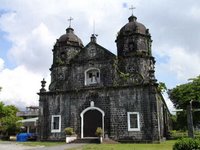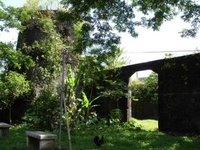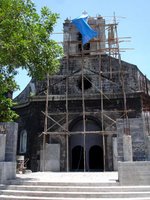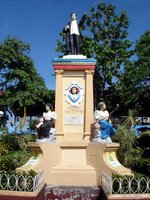I was met at the Legazpi Central Terminal by the staff of the provincial tourism office. Gemma had made arrangements with the governor for them to take me around Albay to search for heritage structures. After a brief stop at the office to meet with the provincial tourism officer, and at the Government Guesthouse to freshen up and drop off my stuff, we were off.
 The first stop on the itinerary was the town of Sto. Domingo, the hometown of Sarung Banggi composer Potenciano V. Gregorio. They have a nice church, the Sto. Domingo de Guzman Church, with two symmetrical bell towers on both sides of the facade. This was compeleted sometime in 1832. Sad to say, entering the church was a disappointment, since it was renovated as always. Oh those priests! They like leaving their mark no matter how ugly! It was a pity since the facade was quite charming.
The first stop on the itinerary was the town of Sto. Domingo, the hometown of Sarung Banggi composer Potenciano V. Gregorio. They have a nice church, the Sto. Domingo de Guzman Church, with two symmetrical bell towers on both sides of the facade. This was compeleted sometime in 1832. Sad to say, entering the church was a disappointment, since it was renovated as always. Oh those priests! They like leaving their mark no matter how ugly! It was a pity since the facade was quite charming.In the small plaza in front of the church is a monument to Andres Bonifacio (they say Bonifacio had a girlfriend from the town which is why they built a monument there) and the mausoleum of Potenciano V. Gregorio.
 From Sto. Domingo, we moved to the next town Bacacay and the Sta. Rosa de Lima Church. Again, this nice church was renovated inside. Sigh! Right beside it were ruins of an older church and one could still recognize some of its features.
From Sto. Domingo, we moved to the next town Bacacay and the Sta. Rosa de Lima Church. Again, this nice church was renovated inside. Sigh! Right beside it were ruins of an older church and one could still recognize some of its features.The next town was Malilipot and its church under the patronage of Our Lady of Mount Carmel. Nice facade but again renovated inside.
 We were then off to Tabaco City which is home to the only national cultural treasure in Bicol, the San Juan Bautista Church. I wonder why the National Museum even considered this church a national cultural treasure. Except for its massive belfry which I must admit is quite an impressive work of art and engineering, the rest of it has been altered just like every other church I've been to in Albay. I wonder how this trend started. But it was sad entering every church seeing the interiors altered.
We were then off to Tabaco City which is home to the only national cultural treasure in Bicol, the San Juan Bautista Church. I wonder why the National Museum even considered this church a national cultural treasure. Except for its massive belfry which I must admit is quite an impressive work of art and engineering, the rest of it has been altered just like every other church I've been to in Albay. I wonder how this trend started. But it was sad entering every church seeing the interiors altered. The facade of the Tabaco Church itself has new oversized stained glass windows. While the old santos in the retablos have been replaced by new ones. If you were to ask me, the candidates for national cultural treasure in Albay should have been the churches in Daraga or Camalig. Oh well!
The facade of the Tabaco Church itself has new oversized stained glass windows. While the old santos in the retablos have been replaced by new ones. If you were to ask me, the candidates for national cultural treasure in Albay should have been the churches in Daraga or Camalig. Oh well! We then checked out the city hall which I had travelled so far to see. I wasn't quite pleased with what I saw. Indeed, it is the most well-preserved municipio in Albay, but there was so much clutter because of ongoing basketball competitions, the entire perimeter fence was covered with galvanized iron sheets maybe because they charged entrance to the games and with the cover, bystanders could not watch. We were also told it was Spanish colonial. But it turns out, the city hall was built during the American colonial period, very typical of town buildings during that time. Oh well, so much for that calendar photo.
We then checked out the city hall which I had travelled so far to see. I wasn't quite pleased with what I saw. Indeed, it is the most well-preserved municipio in Albay, but there was so much clutter because of ongoing basketball competitions, the entire perimeter fence was covered with galvanized iron sheets maybe because they charged entrance to the games and with the cover, bystanders could not watch. We were also told it was Spanish colonial. But it turns out, the city hall was built during the American colonial period, very typical of town buildings during that time. Oh well, so much for that calendar photo.The group had lunch in Tabaco and naturally, I had Bicol express among others. What a shame if I did not eat any Bicol express while in Bicol. But the one I had for lunch wasn't that spicy. After lunch, we drove to Malinao but since it was scorching hot and the church wasn't that appealing, I decided not to go down anymore.
 From there it was off to Tiwi. Looking at the pictures, I was expecting a very quaint church. But we got the shock of our lives when we arrived there since it was currently undergoing uglification! They were plastering the adobe with a layer of cement and were beginning to contruct an oversized portico in front of the church which would completely ruin the facade!
From there it was off to Tiwi. Looking at the pictures, I was expecting a very quaint church. But we got the shock of our lives when we arrived there since it was currently undergoing uglification! They were plastering the adobe with a layer of cement and were beginning to contruct an oversized portico in front of the church which would completely ruin the facade!I immediately texted Archt. Rino Fernandez who heads the Bicol Heritage Program at Aquinas University. He told me that they had already talked to the bishop who agreed that no more old churches would be defaced. They had already stopped construction a month ago but the parish priest is just so hard headed! So they are at it again!
The parish priest is Fr. Jun Barquez and their phone number is (052) 4885187. For crying out loud father, stop wasting church money. You keep on asking donations from the townsfolk for these renovations which are not even needed, for what? So that you could say you left a mark on the church no matter how ugly? I noticed he had a donation box for evangelization, so why not use the money there instead? Sometimes you can't understand the logic of these priests. It's a waste of church money! They seem to like making the contractors happy.
Anyway, Tiwi is known for its halo-halo so we stopped over to have some at a place called DJC Halo-halo a few meters from the church. Not bad at all. But the ones we have in Pampanga have richer flavors. I guess I'm just used to those.
 From Tiwi, it was a long drive to Libon which was on the other side of Albay. Nothing much left there, not even an old church, which is a pity because this used to be Villa Santiago de Libon, the fourth villa established by the Spaniards in the archipelago. We then drove to Polangui, Oas and Ligao City. The next stop was Guinobatan. And on the way, we stopped along the road to buy a snack, a very popular delicacy known as macapuno rice puto which was two layers of puto, one purple and one white with a rich macapuno filling in the center. Yummy!
From Tiwi, it was a long drive to Libon which was on the other side of Albay. Nothing much left there, not even an old church, which is a pity because this used to be Villa Santiago de Libon, the fourth villa established by the Spaniards in the archipelago. We then drove to Polangui, Oas and Ligao City. The next stop was Guinobatan. And on the way, we stopped along the road to buy a snack, a very popular delicacy known as macapuno rice puto which was two layers of puto, one purple and one white with a rich macapuno filling in the center. Yummy! Anyway, Guinobatan struck me because of the colorfully painted municipio, church and monuments, very typical of structures at that time. We just don't realize it because photos are in black and white but facades of buildings during the Spanish and American colonial periods used to be colored quite lively.
Anyway, Guinobatan struck me because of the colorfully painted municipio, church and monuments, very typical of structures at that time. We just don't realize it because photos are in black and white but facades of buildings during the Spanish and American colonial periods used to be colored quite lively.In Camalig was the San Juan Bautista Church which I consider the best-preserved church in Albay. Even the convento is intact. Completed in 1848, the church has Mount Mayon for a backdrop.
 Inside, the ceiling still has its original murals but sad to say the floor had been raised by over a meter covering the original clay tile floor. The altar also has modern santos. I wonder which house in Forbes Park has most of the centuries-old Albay santos. Hehe!
Inside, the ceiling still has its original murals but sad to say the floor had been raised by over a meter covering the original clay tile floor. The altar also has modern santos. I wonder which house in Forbes Park has most of the centuries-old Albay santos. Hehe!Our next stop was the Cagsawa Ruins, the most photographed man-made site in the Bicol Region. The place offered you one of the best views of Mount Mayon.
 Seeing majestic Mayon even for the second time was most worth the long hours on the road. Its nearly perfect cone towers over the landscape in Albay and is a part of life there. I hope the Bicolanos are able to maintain the beauty of their natural heritage, especially Mayon, because indeed, these are treasures.
Seeing majestic Mayon even for the second time was most worth the long hours on the road. Its nearly perfect cone towers over the landscape in Albay and is a part of life there. I hope the Bicolanos are able to maintain the beauty of their natural heritage, especially Mayon, because indeed, these are treasures.From Cagsawa, it was off to the second most photographed man-made site in Bicol, the Our Lady of the Gate Church in Daraga which is perched on top of a hill overlooking Mayon Volcano and the plains below.
 Daraga Church is indeed a sight to behold with its very elaborate facade. As I mentioned earlier, if there should have been a national cultural treasure, it should be this church with its elaborately-decorated facade. But the interior is as modern as it can get an this may explain why the National Museum no longer considered the church. Only the baptistry (below) has remnants of the previous interior and you can see from the carvings on the wall, the remaining patches of paint, and the blue ceramic tiles on the floor that the inside was equally elaborate as well.
Daraga Church is indeed a sight to behold with its very elaborate facade. As I mentioned earlier, if there should have been a national cultural treasure, it should be this church with its elaborately-decorated facade. But the interior is as modern as it can get an this may explain why the National Museum no longer considered the church. Only the baptistry (below) has remnants of the previous interior and you can see from the carvings on the wall, the remaining patches of paint, and the blue ceramic tiles on the floor that the inside was equally elaborate as well. We were told that a former parish priest had the interior renovated and even sold many of the priceless antiques to fund the said uglification. Horrible this priests who leave a mark by wasting church money, selling off priceless works of art which end up in private homes most of the time to pay for useless and ugly renovations so that they will be remembered.
We were told that a former parish priest had the interior renovated and even sold many of the priceless antiques to fund the said uglification. Horrible this priests who leave a mark by wasting church money, selling off priceless works of art which end up in private homes most of the time to pay for useless and ugly renovations so that they will be remembered.From Daraga, it was back to Legazpi City where I took photos of the Cathedral and the Bicol University elemetary and high school Gabaldon buildings (below) which were almost identical to each other. Gemma had asked me to survey it since the high school principal had visited her in Manila that morning (what a coincidence) hoping to ask help in restoring the building since it was quite dilapidated.
 It was 5 p.m. and I realized I had visited almost every town in Albay in a span of nine hours! I had enough for the day and it was back to the guesthouse. After a brief nap, I took a jeep to the center of the Old Albay District (downtown Legazpi is called the Port District) to have some dinner. I could not resist the isaw which was sold all over the place. Again, I had Bicol express. But this time, it was spicy! After checking mail, it was off to bed since I was tired and I had a long day ahead of me tomorrow.
It was 5 p.m. and I realized I had visited almost every town in Albay in a span of nine hours! I had enough for the day and it was back to the guesthouse. After a brief nap, I took a jeep to the center of the Old Albay District (downtown Legazpi is called the Port District) to have some dinner. I could not resist the isaw which was sold all over the place. Again, I had Bicol express. But this time, it was spicy! After checking mail, it was off to bed since I was tired and I had a long day ahead of me tomorrow.